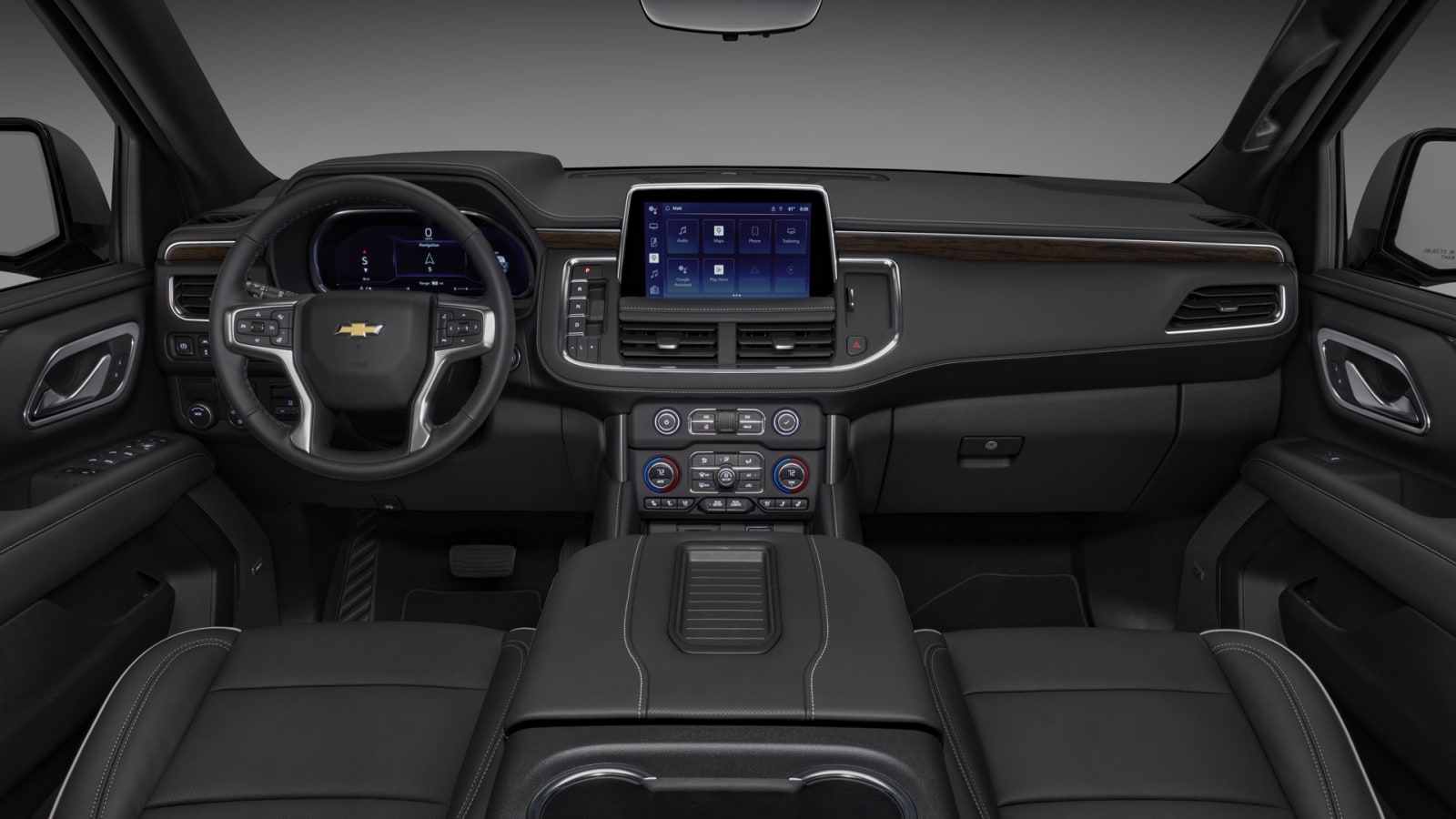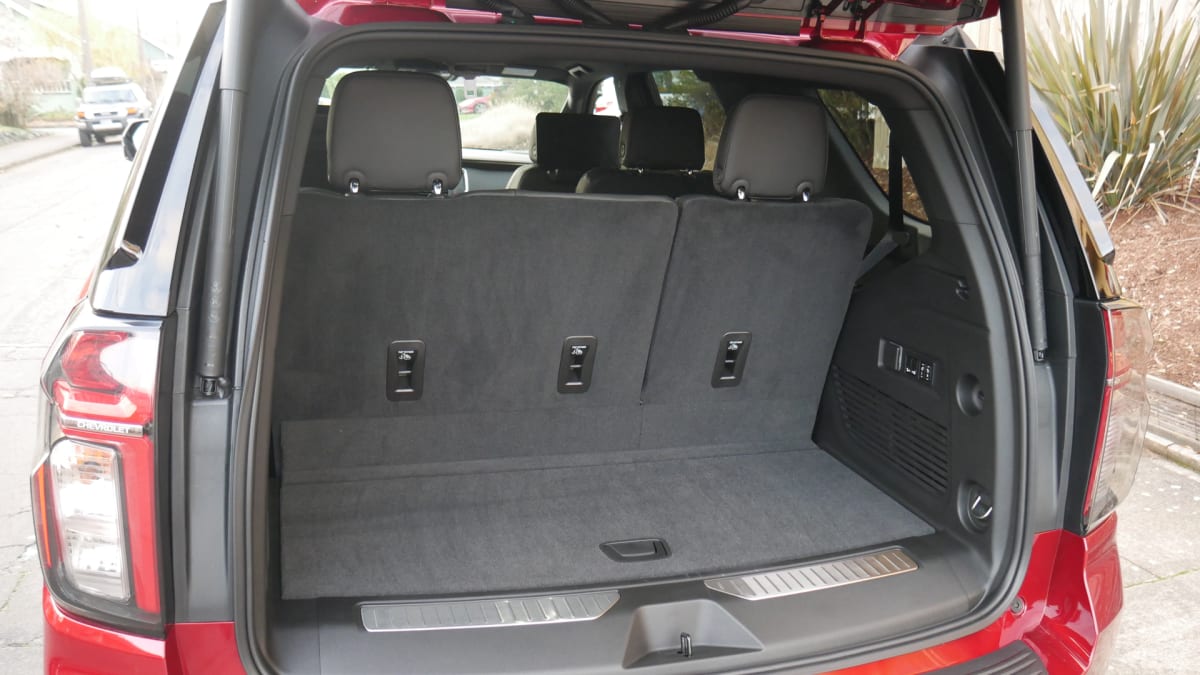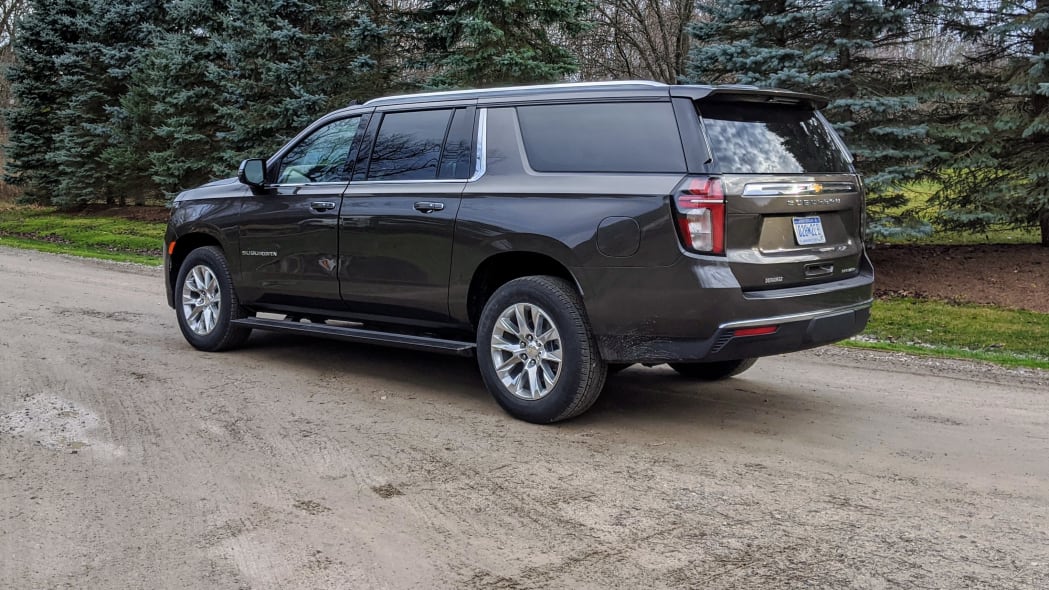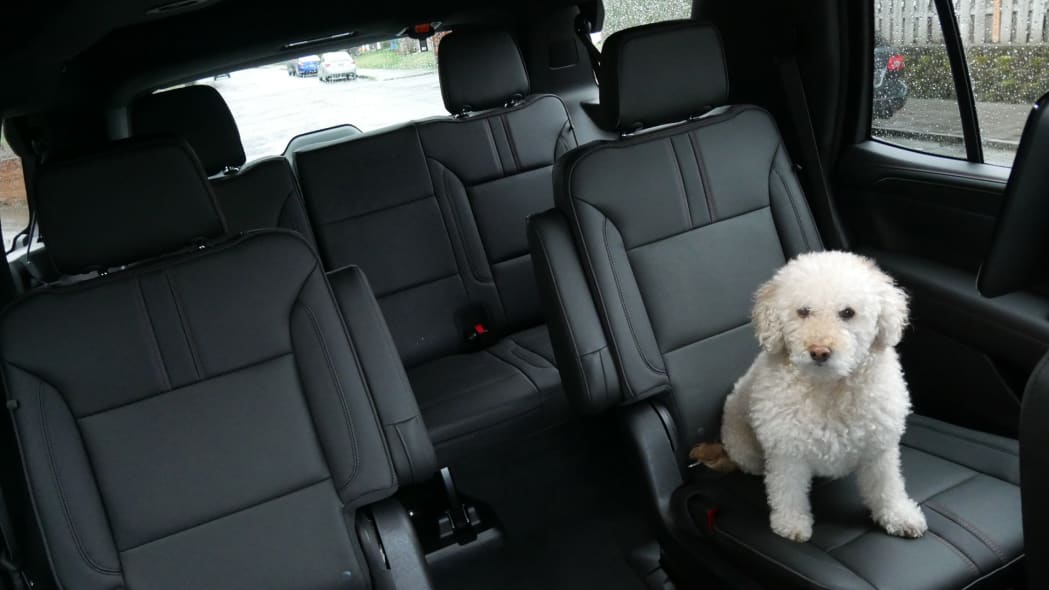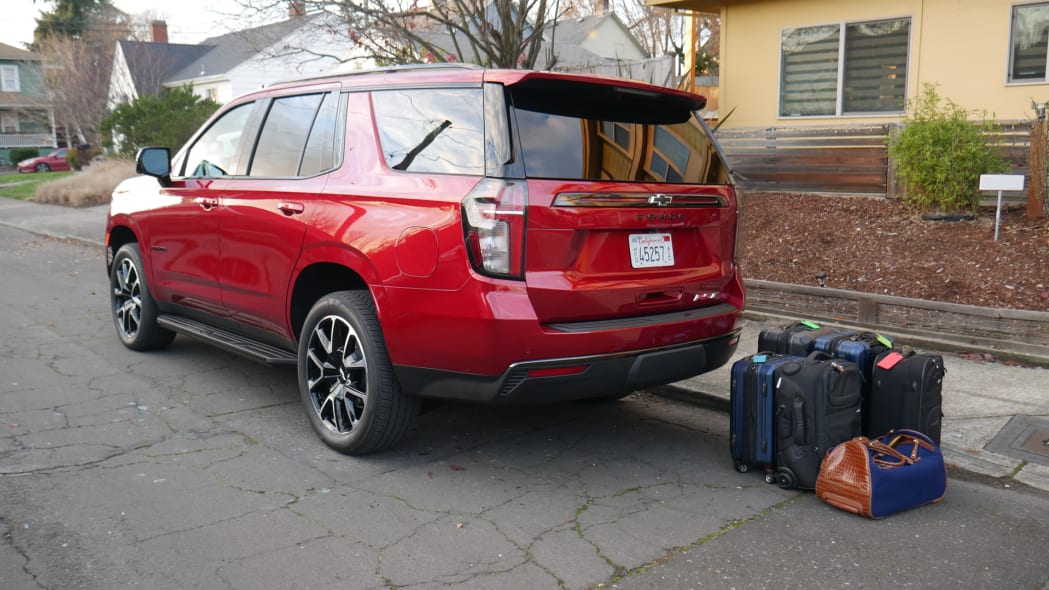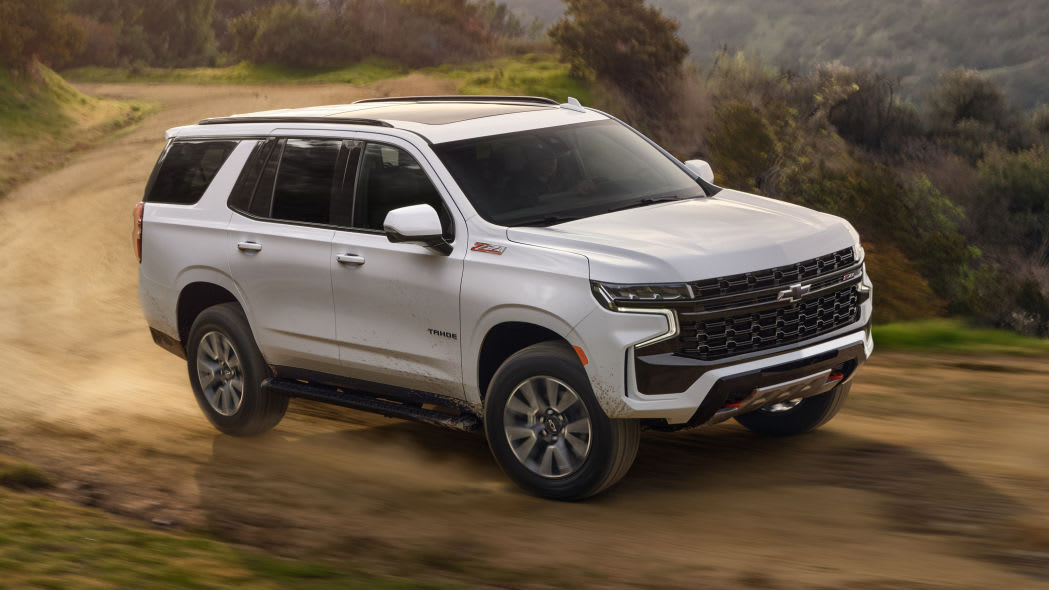Pros: Well-rounded; sophisticated magnetic and air suspension; user-friendly tech; great Duramax diesel option
Cons: Less efficient and/or powerful base engine than rivals; weird shifter; flat seats
There aren’t many areas where the 2023 Chevy Tahoe and Suburban stand out from their full-size SUVs competitors, but they are very well-rounded. Basically, the standard-length Tahoe and extended-length Suburban both score well in all important categories even if they aren’t always the class best or most appealing. For instance, we might prefer the Ford Expedition’s turbo V6 as a base engine and the Jeep Wagoneer’s interior, but the Chevrolets’ total package ultimately adds up to the better buy for the most people.
That’s not to say there aren’t highlights. The optional Duramax diesel is the big one: it provides the same torque as the 6.2-liter V8, will save you money at the pump (yep, even with high diesel prices) and is shockingly quiet. The Tahoe’s variety of suspension options are also a big deal, especially the magnetic and air combo that provides superior ride comfort and body control. The interior’s new Android-powered infotainment system is easy to use and fairly future-proof thanks to over-the-air updates and integrated Google Maps. Finally, should the Tahoe’s style not exactly match yours, the GMC Yukon is basically the same vehicle. It’s just as well-rounded.
Now, as usual, we will point out that it’s important to consider whether you really need the added towing capacity and massive boxy cargo space of a full-size SUV (or the Suburban’s more usable cargo space behind the third-row). Large crossovers like the Kia Telluride or Chevy’s own Traverse offer nearly as much interior space as the Tahoe, but will be cheaper to fuel, provide better handling and maneuverability, and come with cheaper price tags.
Interior & Technology | Passenger & Cargo Space | Performance & Fuel Economy
What it’s like to drive | Pricing & Trim Levels | Crash Ratings & Safety Features
What’s new for 2023?
Adaptive cruise control is now standard on the High Country, while the Premier and High Country will in theory be available with GM’s excellent Super Cruise hands-free highway driving tech at some point. Component shortages have caused this addition to be indefinitely delayed. The only other changes are new versions of silver, gray and red exterior paint.
What are the Tahoe interior and in-car technology like?
Unlike past generations, the current Chevy Tahoe and Suburban get an interior that’s completely different than the Silverado. This used to be a good thing, as the current-generation Tahoe cabin was substantially nicer than the comparable Silverado, but last year’s interior redo of Chevy’s pickup actually tipped the scales in its direction. Whatever, the Tahoe is still a fine place to spend time, with solid materials and build quality for the money. Controls are generally easy to use, and although the push-button transmission selector is a little odd, it’s ergonomically placed.
When it comes to tech, all but the base Tahoe 10.2-inch touchscreen infotainment system that runs Android Automotive software as skinned by GM. This is not to be confused with Android Auto, which is a common car feature that allows the car’s tech interface to control apps on your smartphone (Apple CarPlay is its iPhone equivalent. That’s also in the Tahoe and Suburban, along with CarPlay.) Though the name makes it confusing, Android Automotive is basically an in-car tech interface created by Google (Android) that different car companies can customize, utilizing the tech giant’s various existing features. Among those, it integrates Google’s ecosystem nicely — Google Maps works well as the navigation system. We found the voice-activated Google Assistant (the Android version of Siri) requires an odd “warm-up” period when you first start the car that locks you out of using voice commands for the first 20-30 seconds. That’s inconvenient when you want to get in and get navigation rolling, but at least the Google Assistant works flawlessly once it’s finally ready. You can watch our review of the system in this GMC Yukon Infotainment System walkthrough video.
Much of the other tech in the Tahoe/Suburban is top notch, as the 12-inch digital cluster is nicely laid out with multiple viewing options, and the large head-up display is just as well integrated. You can get a pair of 12.6-inch screens mounted on the headrests for rear passengers to consume content on, too.
How big are the Tahoe and Suburban?
After their complete redesign two years ago, the Tahoe and Suburban gained a significant amount of extra space due to extra length and an independent rear suspension that lowered the floor. The latter was key, as it made the Tahoe’s third row habitable by adults, increased cargo capacity and decreased lift-over height. It also resulted in the Tahoe and Suburban having the same amount of third-row space – it’s only the amount of cargo space behind it that differs.
The end result is the Tahoe and Suburban aren’t quite as large as their Ford and Jeep competitors, but the difference is so small and the space ultimately so vast that it doesn’t matter. That third row may be a bit flat, but even tall adults have loads of room to sit quite comfortably for extended periods of time. We dive deeper into the Tahoe’s newer, larger rear passenger area here.
Behind the third-row seats, the Tahoe has 25.5 cubic feet of space (picture above right). That’s theoretically about a 6-cubic-foot advantage over the Expedition on paper, but in real-world testing, we found the actual difference to be negligible. The Jeep Wagoneer, meanwhile, has appreciably more than both. Still, it’s a genuinely large space for a three-row vehicle. Of course, if you plan to routinely travel with all three rows filled, opting for the Suburban and its added cargo space is a good idea. Its cargo space behind the third row swells to 41.5 cubic feet.
What are the Tahoe fuel economy and performance specs?
The 2022 Chevy Tahoe and Suburban have three engines to pick from. The base engine is a naturally aspirated 5.3-liter V8 making 355 horsepower and 383 pound-feet of torque. It’s coupled to a 10-speed automatic transmission and available with either rear-wheel or four-wheel drive. The Tahoe returns 15 mpg city, 20 mpg highway and 17 mpg combined regardless of drivetrain. The RWD Suburban gets the same, but falls to 15/19/16 with 4WD. These figures are worse than those of the more powerful Ford Expedition.
Available on the Z71, RST, Premier and High Country is a naturally aspirated 6.2-liter V8. It makes 420 horsepower and 460 pound-feet of torque. Like the 5.3-liter engine, it comes with a 10-speed automatic and either rear-wheel or four-wheel drive. City and highway fuel economy differs somewhat by drivetrain, trim level and Tahoe or Suburban, but all versions with this engine get 16 mpg combined.
A unique offering for the GM full-size SUVs is the diesel 3.0-liter inline-six. It’s the only engine like it in the class. It makes 277 horsepower and 460 pound-feet of torque and will also get the 10-speed automatic. It obliterates the fuel economy of the gas engines, with 21 mpg city, 28 mpg highway and 24 mpg combined for the 2WD Tahoe and 20/26/22 with 4WD. The Suburban is basically the same. Diesel prices will greatly determine how much you’ll save at the pump with this engine, but the gigantic fuel economy advantage should still come out in the Duramax’s favor.
Towing capacities are between 7,500 and 8,000 pounds depending on body style, engine and drivetrain. The diesel is the best choice, but only slightly. A tow package increases capacity across the board and actually results in the 5.3-liter being slightly better, but again, the difference is small.
The longer Suburban, pictured above
What are the Tahoe and Suburban like to drive?
There are a wide array of Tahoe and Suburban powertrain and chassis combinations, and we haven’t driven them all, but the versions we’ve driven have been impressive. Four suspension offerings are available: a fixed steel spring and shock system; an air suspension; a steel spring suspension with magnetic dampers; air suspension with magnetic dampers. We haven’t sampled the base system, but we would nevertheless suggest a Tahoe or Suburban with the magnetic dampers. It provides a glassy smooth ride, limited body roll, and its controlled enough to eliminate nearly all the shimmies and shudders that crop up in large, body-on-frame vehicles.
The air suspension on its own lets those body wiggles through more, but is still pleasant. In the default comfort mode, it rides fairly soft with moderate body roll, and the sport mode stiffens things up noticeably, but without becoming uncomfortable. Regardless of suspension, you get the same steering, which is excellent. It’s nicely weighted, and quite precise. And even with the more roly-poly base air suspension, the big SUV handles well with good turn-in and a stable, composed feel even over bumpy corners.
We’ve also now driven Tahoes/Suburbans with every available engine. The 5.3-liter V8 provides perfectly adequate acceleration, but it’s no match for the Ford Expedition’s silky smooth and far more powerful turbo V6. The 6.2-liter is a much better contender and does liven things up a bit, though we still wouldn’t call it fast. Ultimately, we think the Duramax diesel is the best choice. It certainly won’t be fast, either, but its benefits are many. Its peak torque matches the 6.2-liter, but occurs at 1,500 rpm rather than 4,100. That makes it well-suited to towing and results in acceleration that feels stronger off the line. It’s shockingly quiet, both inside and outside, lacking the expected, obnoxious diesel clatter, and is the most efficient engine offering.
What other Tahoe and Suburban reviews can I read?
2021 Chevy Suburban Diesel First Drive
Our most substantial drive of the Suburban, plus our first impressions of the new Duramax diesel option.
2021 Chevy Tahoe Rear Seat Driveway Test + Video
The switch to an independent rear suspension has profoundly increased third-row seat space for 2021. There are several other new features, which we highlight in this post with video. Riswick’s dog also makes an appearance.
2021 Chevy Tahoe Luggage Test | How much fits behind the third row?
The independent rear suspension makes a huge difference for cargo space, specifically behind the third row. We take a closer look and compare it to the Ford Expedition.
2021 Chevy Tahoe Suspension Deep Dive | Explaining the IRS you should be happy about
We’ve talked a ton about the many benefits of GM switching the Tahoe and Suburban to an independent rear suspension. Now, in this deep dive review, engineer Dan Edmunds explains the “how” of the new suspension design plus other details about its available air suspension with magnetic dampers.
Chevy Tahoe Premier Video Walkaround and Interior Review
Autoblog Editor-in-Chief Greg Migliore takes you inside the Tahoe’s Premier trim level.
2021 Chevy Tahoe First Drive
We take our first drive in the new Tahoe and find that it drives well and has a quality interior.
What are the 2023 Tahoe and Suburban prices?
Considering that GM repeatedly increased Tahoe and Suburban pricing last year, it’s certainly plausible that some or all of the below prices will change at some point in the coming months. All prices include the hefty $1,795 destination charge. Four-wheel drive adds $3,000 to all prices but the Z71, which includes it as standard.
Tahoe
LS: $54,295
LT: $59,795
RST: $63,295
Z71: $65,295
Premier: $68,095
High Country: $74,895
Suburban
LS: $56,995
LT: $62,495
RST: $65,995
Z71: $67,995
Premier: $70,795
High Country: $77,595
The base LS (pictured below left) comes with basically every feature you’d ever need, but considering few people buy a Tahoe or Suburban because they literally need one, we’re guessing the LT’s key extras like leather seating, heated front seats, 10.2-inch touchscreen, digital instrument panel, Bose stereo and wireless charging will make it the go-to starting point.
From there, the lineup forks in different directions. The RST is equipped comparable to the LT, but gets darker and body-colored exterior trim. Basically, it’s looks sportier. The Z71 looks more rugged (pictured above) and it is more rugged thanks to all-terrain tires, a skid plate, a unique front fascia that provides a better approach angle and clearance, and the option of the height-adjustable air suspension (also available on upper trims). Things then get increasingly luxurious with the Premier and High Country (pictured below right), with the latter coming standard with the 6.2-liter V8, magnetic and air suspension setup and 22-inch wheels to go with every luxury, convenience and safety feature on the menu.
What are the Tahoe/Suburban safety ratings and driver assistance features?
The Tahoe and Suburban come standard with automatic emergency braking with pedestrian detection, lane-departure warning and lane-keeping assist, front and rear parking sensors, automatic high-beam headlights and a rear seat reminder. Optional safety features that come standard on some higher trim models include reverse automatic emergency braking, blind-spot warning, rear cross-traffic alert, parking sensors and adaptive cruise control. GM’s Super Cruise hands-free highway driving system can replace adaptive cruise control as an option on the Premier and High Country, but its availability is delayed due to chip shortages.
The Tahoe and Suburban received four out of five stars for overall crash protection from the NHTSA, including a four-star frontal rating, five-star side rating and three-star rollover rating. The Insurance Institute for Highway Safety has not tested the latest generation.
Related video:

